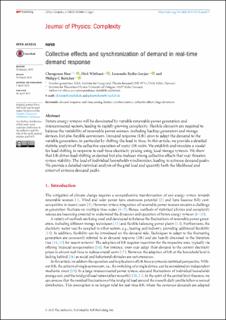| dc.contributor.author | Han, Chengyuan | |
| dc.contributor.author | Witthaut, Dirk | |
| dc.contributor.author | Rydin Gorjao, Leonardo | |
| dc.contributor.author | Böttcher, Philipp | |
| dc.date.accessioned | 2022-08-22T07:26:38Z | |
| dc.date.available | 2022-08-22T07:26:38Z | |
| dc.date.created | 2022-06-06T14:37:23Z | |
| dc.date.issued | 2022-04-28 | |
| dc.identifier.issn | 2632-072X | |
| dc.identifier.uri | https://hdl.handle.net/11250/3012809 | |
| dc.description.abstract | Future energy systems will be dominated by variable renewable power generation and interconnected sectors, leading to rapidly growing complexity. Flexible elements are required to balance the variability of renewable power sources, including backup generators and storage devices, but also flexible consumers. Demand response (DR) aims to adapt the demand to the variable generation, in particular by shifting the load in time. In this article, we provide a detailed statistic analysis of the collective operation of many DR units. We establish and simulate a model for load shifting in response to real-time electricity pricing using local storage systems. We show that DR drives load shifting as desired but also induces strong collective effects that may threaten system stability. The load of individual households synchronizes, leading to extreme demand peaks. We provide a detailed statistical analysis of the grid load and quantify both the likelihood and extent of extreme demand peaks. | en_US |
| dc.description.sponsorship | This research was supported by the German Federal Ministry of Education and Research (BMBF) via the Grant CoNDyNet with Grant No. 03EK3055 and the Helmholtz Association via the Grant Uncertainty Quantification—From Data to Reliable Knowledge (UQ) with Grant No. ZT-I-0029. Funded by the Deutsche Forschungsgemeinschaft (DFG, German Research Foundation) with Grant No. 491111487. | en_US |
| dc.language.iso | eng | en_US |
| dc.publisher | IOP Publishing | en_US |
| dc.relation.ispartofseries | Journal of Physics: Complexity;Volume 3, Number 2 | |
| dc.relation.uri | https://iopscience.iop.org/article/10.1088/2632-072X/ac6477 | |
| dc.rights | Navngivelse 4.0 Internasjonal | * |
| dc.rights.uri | http://creativecommons.org/licenses/by/4.0/deed.no | * |
| dc.subject | Demand responses | en_US |
| dc.subject | Real-time pricing | en_US |
| dc.subject | Batteries | en_US |
| dc.subject | Synchronization | en_US |
| dc.subject | Collective effects | en_US |
| dc.subject | Large deviations | en_US |
| dc.title | Collective effects and synchronization of demand in real-time demand response | en_US |
| dc.type | Peer reviewed | en_US |
| dc.type | Journal article | en_US |
| dc.description.version | publishedVersion | en_US |
| dc.rights.holder | © 2022 The Author(s) | en_US |
| dc.source.articlenumber | 025002 | en_US |
| cristin.ispublished | true | |
| cristin.fulltext | original | |
| dc.identifier.doi | https://doi.org/10.1088/2632-072X/ac6477 | |
| dc.identifier.cristin | 2029650 | |
| dc.source.journal | Journal of Physics: Complexity | en_US |
| dc.source.volume | 3 | en_US |
| dc.source.issue | 2 | en_US |
| dc.source.pagenumber | 1-11 | en_US |
| dc.relation.project | Deutsche Forschungsgemeinschaft: 491111487 | en_US |
| dc.relation.project | Bundesministerium für Bildung und Forschung: 03EK3055 | en_US |
| dc.relation.project | Helmholtz-Gemeinschaft Deutscher Forschungszentren: ZT-I-0029 | en_US |

